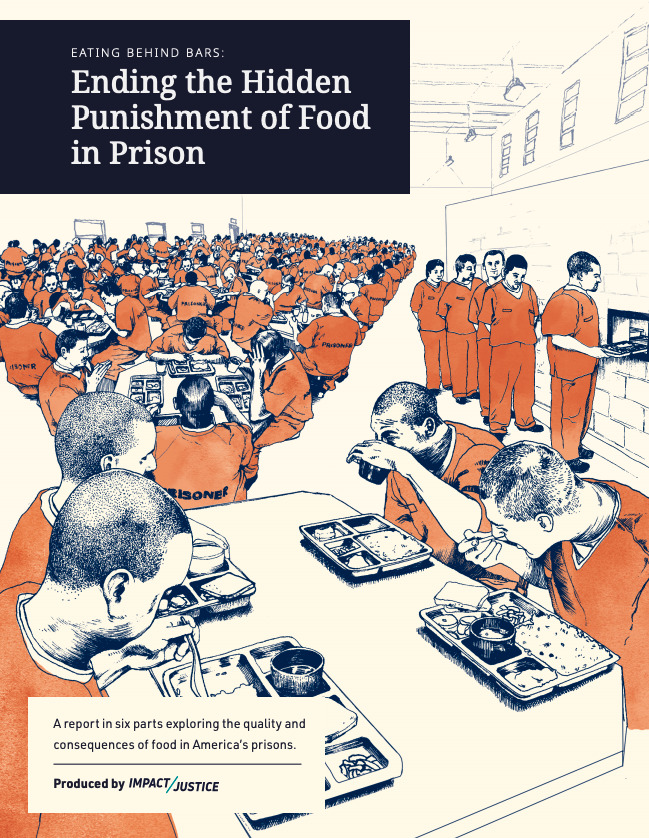“Eating Behind Bars: Ending the Hidden Punishment of Food in Prison” shows how prison food damages incarcerated people and our entire society, provides recommendations for a positive path forward
OAKLAND, CA — Today Impact Justice announced the release of the first part of its national report “Eating Behind Bars: Ending the Hidden Punishment of Food in Prison.” This first-of-its-kind report examines the long-overlooked issue of the damaging and degrading food served to incarcerated people across the country and explores the harmful trends in prison food through first-hand accounts and original research that bring these issues to life.
“Eating Behind Bars highlights a major issue that has never been studied before” said Alex Busansky, President of Impact Justice. “It reveals how people in prison are being fed a diet the rest of us has been advised to avoid for decades. This not only affects the more than 2.3 million incarcerated people in the U.S., but all of us. If we want to create a safer and healthier society for everyone, we must transform the quality of food we serve to incarcerated people.”
Some key trends uncovered in the report include:
- 75% of respondents from a national survey conducted among formerly incarcerated people said they were served spoiled or rotten food while in prison.
- 94% of survey respondents couldn’t eat enough in prison to feel full.
- The majority of states spend under $3 per day to feed an incarcerated person. One state spends just $1.02 to feed a person a day.
“The prison food experience is a prime example of how we depend on a dehumanizing criminal legal system to address harm,” said Leslie Soble, Research Fellow at Impact Justice and lead author of the report. “We know food has the power to nourish our bodies, affirm who we are as individuals, and connect us to people, places, and cultures. By serving better food in prison, we can help nurture people’s full potential post-release as we work to dismantle the structures that drive mass incarceration.”
Part One: Food on a tray, released today, provides a vivid portrait of mealtime in prison, characterized by food that is unappetizing, poor in quality, and sometimes unsafe. It also describes the harmful impact of COVID-19 on the quality of food in prison across the country. In subsequent days, we delve into:
- Part Two: When food harms offers an up-close look at the nutritional value and quantity of food served in prison, and explores the relationship between diet and physical and mental health for incarcerated people.
- Part Three: From the chow hall to “home cooking” in prison delves into the physical environments where prison meals take place and their effects on the health and well-being of incarcerated people.
- Part Four: The prison food machine paints a map of the operational landscape — the state-level policies and food service practices inside prisons that determine the quality of food in prison.
- Part Five: Who’s looking, who’s listening studies the systems and avenues that should function to hold departments of corrections accountable for the quality of food in prison.
- Part Six: A path forward provides key insights to encourage and guide change toward a more positive and nourishing eating experience in prison.
“Food has the power to create change; it’s about more than just sustenance,” said José Andrés, renowned chef, Food in Prison Project advisory board member, owner of ThinkFoodGroup, and founder of World Central Kitchen. “Everyone deserves this, including people who are in prison.”
The full report, Eating Behind Bars: Ending the Hidden Punishment of Food in Prison, will be released in six parts over the course of a week beginning December 2, 2020, with the full report available December 9, 2020. Read the report and learn more about Impact Justice’s Food In Prison Project by visiting https://impactjustice.org/impact/food-in-prison/.
###
Impact Justice is a national innovation and research center advancing new ideas and solutions for justice reform. We work to dramatically reduce the massive number of youth and adults in our justice system, improve conditions and outcomes for those who are incarcerated, and provide meaningful opportunities for formerly incarcerated people to rejoin their communities. For more information, visit: http://ImpactJustice.org.



